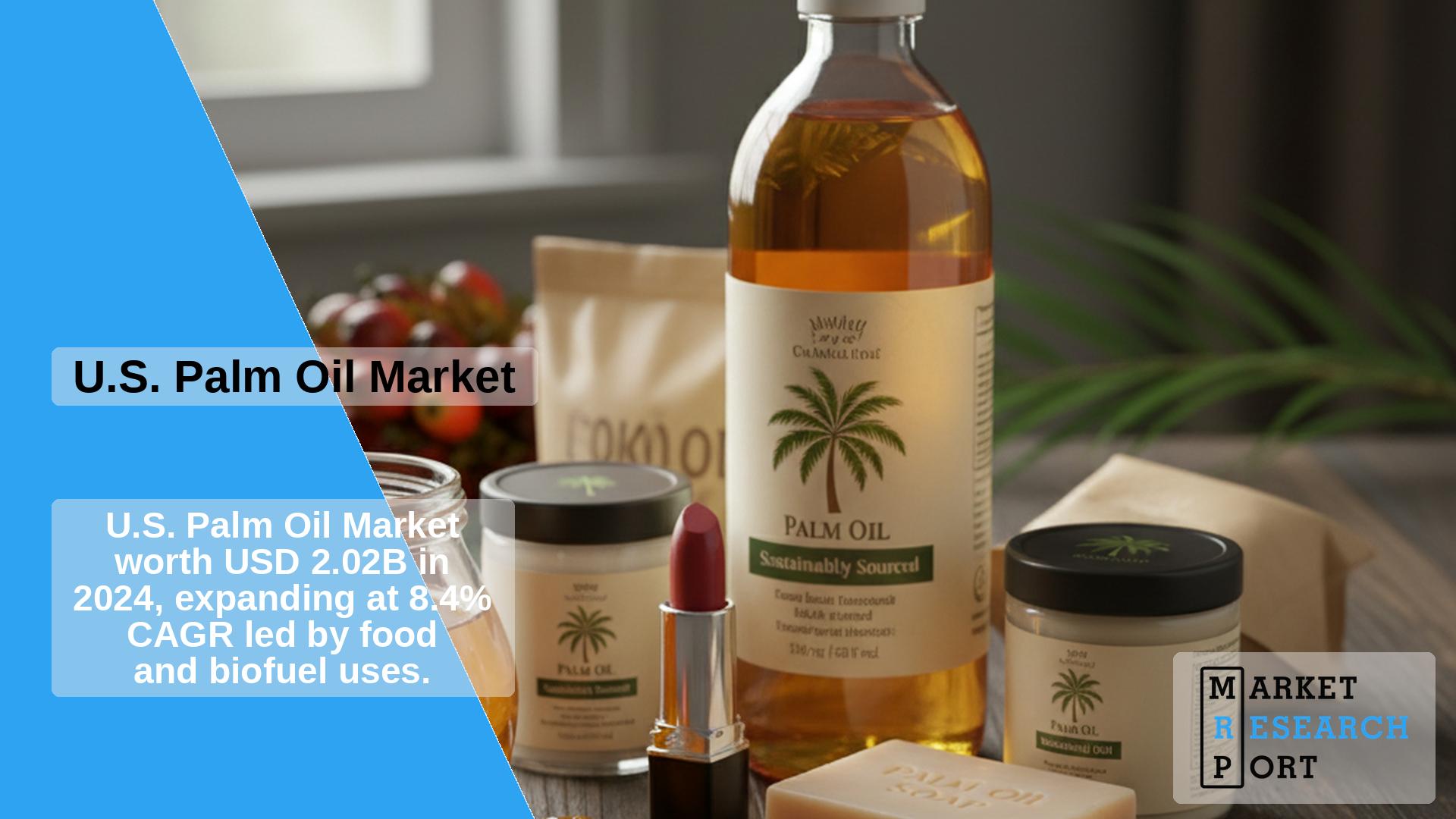
The palm oil market in the United States reached USD 2.02 billion in 2024 and is forecasted to experience robust growth at a CAGR of 8.4% from 2025 to 2030. Growth is supported by increasing demand across food, beverages, biofuels, energy, personal care, and cosmetics industries. The sector is marked by intense competition, with numerous companies striving to differentiate themselves through production capacity, broad distribution networks, and product quality initiatives.
Palm oil is a staple vegetable oil widely incorporated in common supermarket goods. It is especially favored in products like chocolate, margarine, ice cream, and cookies, providing desirable texture and appearance. Its versatile characteristics such as a neutral flavor, optimal melting profile, and health value allow its use in diverse products, including cooking oils, supplements, and food condiments.
This oil is preferred not only for its performance but also for its cost advantage over other vegetable oils. Producers in developing nations often benefit from lower production expenses compared to those in developed regions. U.S. manufacturers continue seeking ways to optimize costs and comply with strict quality standards while maintaining competitive pricing strategies.
Growing interest in sustainable products has heightened the appeal of certified sustainable palm oil (CSPO), and the expansion of the biofuel market has boosted demand for palm oil as a biodiesel feedstock. Its cost-effectiveness and functionality as an ingredient in foods and personal care products make palm oil a valuable commodity for manufacturers. Nutritional benefits, such as antioxidant content, further contribute to the rising popularity of palm oil-based goods.
However, palm oil’s association with environmental challenges—including deforestation and loss of biodiversity—discourages some consumers and adds complexity for producers. Health-related concerns focused on the oil’s saturated fat content also present challenges for broader use, especially in foods. Global pricing fluctuations driven by weather and international relations introduce significant unpredictability. Meeting sustainability certification requirements can be demanding, mainly impacting smaller producers. Additionally, competition from other vegetable oils—like soybean and canola—poses an ongoing challenge to market expansion.
Increased consumer demand for eco-friendly products is creating new opportunities for certified sustainable palm oil, providing a premium option for buyers focused on ethical sourcing. Expansion in the biofuel segment, supported by regulatory incentives, encourages greater palm oil utilization. Innovative product development, targeting enhanced nutrition and better functional properties, may attract health-conscious individuals and broaden the market. Strategic alliances with food and manufacturing industries could help maintain stable demand, securing palm oil’s place as a preferred ingredient.
Food and beverage applications accounted for the largest portion of the U.S. market, at 68.9% in 2024. This success reflects a high frequency of palm oil usage in processed foods and a broadening product base that requires palm oil as a vital raw material. Population growth and demand for diverse products continue to elevate market size. Personal care and cosmetics, as well as biofuel and energy sectors, are close followers, with personal care a well-established market and biofuels positioned for rapid development as clean energy technologies advance.
As sustainable eating patterns and plant-based trends grow more prominent, product portfolios are expanding—especially within food and beverages. Biofuels are rising in importance due to fading non-renewable resources, making palm oil a potential cornerstone for future energy solutions. Demand for palm oil in animal feed applications is also growing. With its affordability and accessibility, palm oil is a preferred energy source for livestock nutrition, enhancing efficiency and supporting weight gain, particularly in dairy cattle. As animal product consumption rises, the need for palm oil in agriculture is expected to follow.
Crude palm oil (CPO) was the most significant contributor to market share in 2024, accounting for 82.3%. Its popularity stems from major food and beverage uses and its vitamin content, especially Vitamin A, which increases its nutritional appeal. CPO is extensively used both in edible goods and in cosmetics and pharmaceutical manufacturing, serving as a core ingredient across these sectors.
Palm kernel oil (PKO) is also experiencing rising demand due to its flexible nature, finding applications in food products for stability and texture, as well as in soaps and lotions for personal care. PKO’s value is enhanced in biofuel production and in the manufacturing of industrial chemicals. Despite ongoing concerns about environmental impact, PKO’s broad utility continues to drive demand within U.S. markets.
Prominent enterprises in the industry include Wilmar International Ltd. and ADM.
| Report Attribute | Details |
| Market size value in 2025 | USD 2.24 billion |
| Revenue forecast in 2030 | USD 3.36 billion |
| Growth rate | CAGR of 8.4% from 2025 to 2030 |
| Actual data | 2018 – 2024 |
| Forecast period | 2025 – 2030 |
| Quantitative Units | Volume in kilotons, revenue in USD million/billion, and CAGR from 2025 to 2030 |
| Report coverage | Revenue forecast, competitive landscape, growth factors, and trends |
| Segments covered | Product, end-use |
| Key companies profiled | ADM; Wilmar International Ltd.; Cargill; Colonial Chemical; CIRANDA; PK Chem Industries Ltd; GreenChem Industries, LLC; Agrolane; Mehsom Corpl |
This analysis provides nationwide forecasts for revenue and volume with the latest trends reviewed for each sub-segment from 2018 to 2030. Segmentation focuses on product and end-use categories:
The market was valued at USD 2.02 billion in 2024 and is expected to increase to USD 2.24 billion in 2025.
The market is predicted to grow at a CAGR of 8.4% during 2025-2030, reaching an estimated USD 3.36 billion by 2030.
The RBD Palm Oil segment held the largest market share in 2024.
Leading companies include ADM, Wilmar International Ltd., Cargill, Colonial Chemical, CIRANDA, PK Chem Industries Ltd, GreenChem Industries, LLC, Agrolane, and Mehsom Corpl.
Growing consumption in sectors such as food and beverages, biofuels, personal care, energy, and cosmetics is driving market expansion.